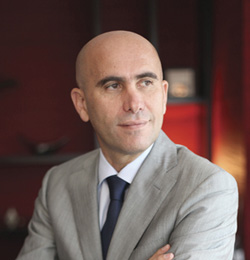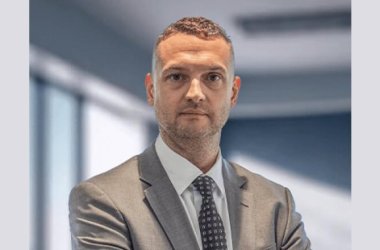 Nidal Abou-Ltaif, the swashbuckling lead of communications and networking major Avaya in the region, talks about how the Middle East remains on the forefront of technology adoption, and how partners will drive the company’s growth.
Nidal Abou-Ltaif, the swashbuckling lead of communications and networking major Avaya in the region, talks about how the Middle East remains on the forefront of technology adoption, and how partners will drive the company’s growth.
What are the three biggest trends affecting global enterprises today?
A: There is cloud – it is attractive and makes sense. It may not be entirely formalised, but everyone is moving in that direction. Along with cloud, there are associated technologies like virtualisation.
Then there is the rise of intelligent devices, which creates a lot of challenges. This is a market trend that people can’t ignore.
From the communications side, the trend is SIP, which we believe will become the standard, and replace multiple protocols to become the open standard. These are the trends that will drive our industry.
Q: What is Avaya’s play in the cloud?
A: Everybody is addressing it in different ways – we play it in from the communication angle. We lead when it comes to creating and building our technology on SIP protocols. We are addressing the cloud, by building technologies that provide the customer flexibility and can be integrated into their chosen cloud model (private, semi-private or public).
We don’t know everything about the cloud. There are early days, and it is not mature, and the end-user does not know exactly what he wants from the cloud.
From Avaya perspective we are committed to cloud solutions. We have a call centre solution for the cloud that we are implementing in the region here. And we are in the process of implementing a UC solution for the cloud. We are aggressive in that. We didn’t essentially call it the cloud, but even a few years back our customers used to have call centre in one place and agents everywhere – isn’t that operating in the cloud?
We are building up to offer it to our customers to offer it as a service to the public. We are going that extra step and that is what we are currently implementing in MEA.
We are working with our partners and our specialist service providers for more cloud-oriented solutions as well. Our strategy was always to lead using the open standards.
Q: You stated that the SIP protocol will become dominant soon. When do you see that happening?
A: We believe SIP is going to change the world, just as TCP/IP did sometime back. Maybe it will take a bit of time, but we believe it is going to grow faster than expected. Customers want it. We are starting to see service providers in our region (KSA, Africa, Turkey and UAE), providing sub-trunks to the end-user. It means that if the service provider starts to adopt SIP, then enterprises have to change to SIP.
We believe that SIP is the future of Avaya, we have been standardising on it. We built Aura on SIP, with the idea that enterprises can migrate and eventually communicate on the protocol. That requires products like Aura, session border controller, and Sipera technologies.
Having SIP equipment to communicate makes it much easier, more cost effective and allows them to do multi modelling – so when you have SIP technology you will be able to do video, calls, data, chat – that vision we cannot do without SIP.
We believe that customers need to migrate to SIP slowly. We did some of the big installations in the UAE here, and some banks (like Emirates NBD) have adopted the technology. They wanted to use Flare on iPad, organisations can’t do that unless they have SIP. We helped them move to the future with Aura 6, so that they can migrate slowly.
Q: Please define Avaya’s play in the other major trends you had outlined.
A: I would like to focus on something that we touch everyday and is very high demand – it is bring your own device (BYOD). We have started to see that growing faster than we anticipated.
BYOD has a lot of challenges. However, IT departments cannot resist it for long. And that’s because the impact on productivity would be very high. If I am used to this device, and I use it all the time, then I am more familiar with it and I have more data on it. I have more access on it, and if I keep using it personally and at any time, any place, anywhere – that brings more productivity by itself.
These people with BYOD, they create a challenge for the organisation. To capitalise on this trend, organisations need to build a new mindset that understands what elements they are not in control, and how they can secure themselves better under the circumstances. Remember, with BYOD, the choice shifts from IT to the user.
That changes things. We help our customers and their IT departments prepare for BYOD by providing technology and business consultancy, and encouraging them to take to the trend.
We at Avaya walk the talk, which is why we are trying to make our technology available over multiple devices. We have released our own Flare on iPad. We are happy that some of our customers have already adopted this and we are piloting this with other customers, including the likes of big banks. They are using Flare on iPad because they are already using the device – either on their own or through the organisation. They use it for their personal reasons, they communicate with it, they walk around with it, they have constant access with it, but that device alone cannot be a phone. What we have done with Flare is convert it into a phone as well. This is what we have been doing to encourage adoption of BYOD in the market.
Avaya is moving it’s infrastructure totally to SIP, so we can allow people to bring their own device. We are usually a conservative company when it comes to IT and security, but we have changed this. We have announced that we will be rolling out to SIP and we will finish this by December this year.
The roll out will be across Avaya EMEA, and this will make us one of the biggest SIP bases. We are using our own technology to allow our people to have the freedom of using any device, connect in any way they wish and communicate the way they want to, anywhere, anytime, while still keeping it secure.
By GITEX 2012 we should be able to demonstrate some of our own uses, and also how our technology integrates and works well with other solutions in the market, like Microsoft’s solutions. We are making ourselves into the best example of what we are preaching.
Q: BYOD in the region – are enterprises really adopting the same, and is there a particular kind of organisation that is likely to take to it more than others?
A: There is a myth that enterprises here are not able to adapt and make changes. I cover the entire Middle East, Africa and Turkey markets, and I have to say that we are much faster than the rest of the world in adopting technology. We have hunger; we are hungry to use technology. Our IT departments adapt quickly to changes, and most CIOs are wise enough to realise that they should lead the pack when it comes to technology adoption.
What customers are trying to do is, as interest in BYOD grows they are trying to establish all the relevant rules around security, and make sure that the organisation is protected before they take up the route. This is not an easy task.
IT at this juncture should not say no – they would have to make sure that they have compliance measures in place and convince the organisation that they are putting in all the necessary security measures to make interactions safe. To make it really simple, our work is a bit like laying down the road, and people will pick what vehicle they will want to drive on it.
We are playing the role of advisor to our customers. We are telling them that it is not just about providing technology. We are telling them that it is not just about replacing solutions, like our competition would be likely to do, but about moving slowly and integrating it with the functioning of the organisation. Our suggestion would be to let executives in the firm it out first, so they could understand it better and then lead the changes from it. You have to understand that every organisation has its own agenda.
Q: How has Avaya grown as an entity in the region in the last 18 months?
A: We have maintained good growth to the previous year, despite the many challenging times in the region. More important to us than growth is to ensure that all our staff, in all the countries that had problems, were safe. On top of that, we have continued to invest and remain committed to the region.
These things are outstanding achievements. That by itself reflects good business.
Q: Please define Avaya’s strategy and how you plan to grow in the next 18 months.
A: First of all, we are opening five offices in Africa. Today we finalised Kenya and Nigeria is next. We are going to Africa in a very aggressive way. Our investment in the ME and South Africa continue to be the same. Inspite of all the trouble in the region, we added more people, more headcount, so we are investing in headcount, investing on touching customers more, and to get mindshare, sell and convince them about Avaya technology.
From a channel perspective we are spending and our growth will come through our partners; because we believe they are the extension. We cannot cover the whole market, so we focus a lot on the channel. We will continue to be100% indirect business in the region – other than a few customers everything is indirect. We have no intentions to grow through direct business – our intention it to grow through channels.
We have realised that there is a lack of professional services to implement this technology. So we are investing in professional services – again, not to take away from our business partners services but to hand hold them, making sure that we do the first installation and help them to grow the business.
To simplify, the best way to grow is to watch the changes, and adapt to it quickly – that is the only way to grow. You can’t have any plan in place, our countries are changing. We sleep in a situation, and we wake up to something else.





